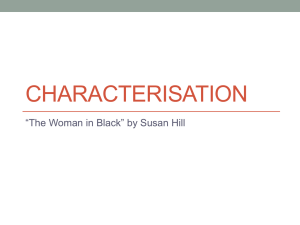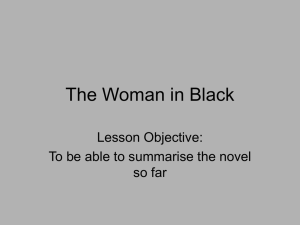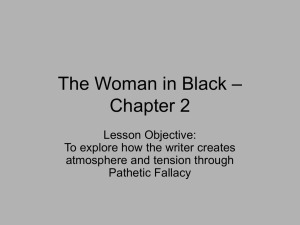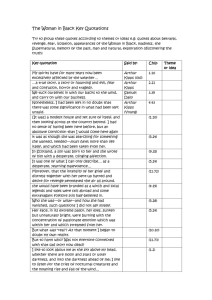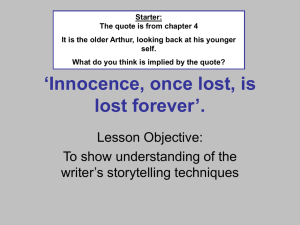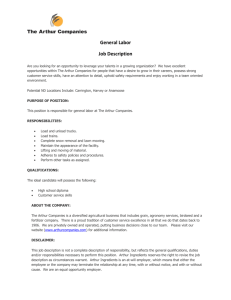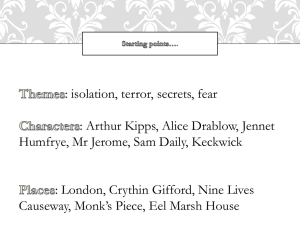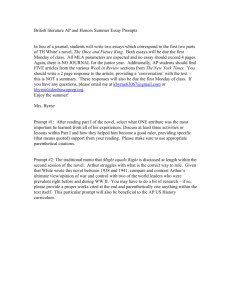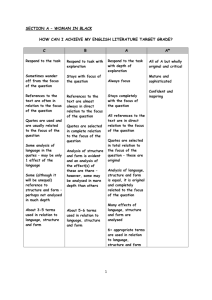WiB revision notes.
advertisement
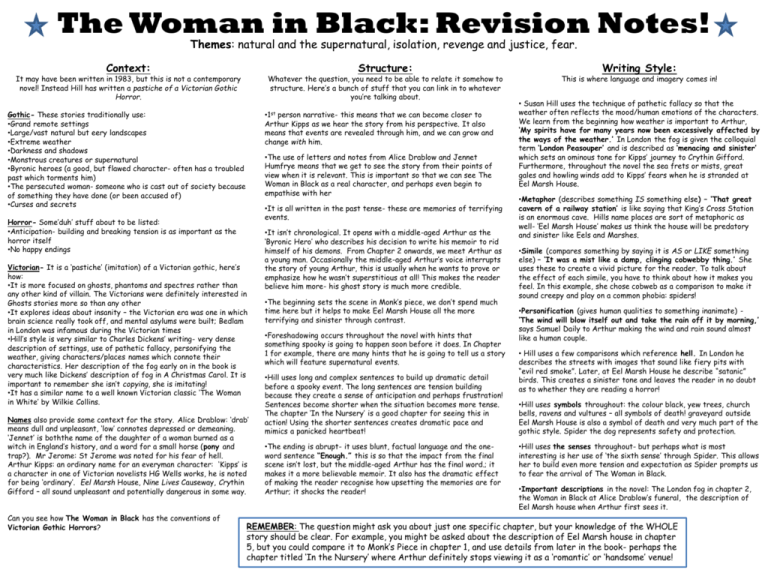
The Woman in Black: Revision Notes! Themes: natural and the supernatural, isolation, revenge and justice, fear. Context: Structure: It may have been written in 1983, but this is not a contemporary novel! Instead Hill has written a pastiche of a Victorian Gothic Horror. Whatever the question, you need to be able to relate it somehow to structure. Here’s a bunch of stuff that you can link in to whatever you’re talking about. Gothic- These stories traditionally use: •Grand remote settings •Large/vast natural but eery landscapes •Extreme weather •Darkness and shadows •Monstrous creatures or supernatural •Byronic heroes (a good, but flawed character- often has a troubled past which torments him) •The persecuted woman- someone who is cast out of society because of something they have done (or been accused of) •Curses and secrets •1st person narrative- this means that we can become closer to Arthur Kipps as we hear the story from his perspective. It also means that events are revealed through him, and we can grow and change with him. •The use of letters and notes from Alice Drablow and Jennet Humfrye means that we get to see the story from their points of view when it is relevant. This is important so that we can see The Woman in Black as a real character, and perhaps even begin to empathise with her •It is all written in the past tense- these are memories of terrifying events. Horror- Some’duh’ stuff about to be listed: •Anticipation- building and breaking tension is as important as the horror itself •No happy endings Victorian- It is a ‘pastiche’ (imitation) of a Victorian gothic, here’s how: •It is more focused on ghosts, phantoms and spectres rather than any other kind of villain. The Victorians were definitely interested in Ghosts stories more so than any other •It explores ideas about insanity – the Victorian era was one in which brain science really took off, and mental asylums were built; Bedlam in London was infamous during the Victorian times •Hill’s style is very similar to Charles Dickens’ writing- very dense description of settings, use of pathetic fallacy, personifying the weather, giving characters/places names which connote their characteristics. Her description of the fog early on in the book is very much like Dickens’ description of fog in A Christmas Carol. It is important to remember she isn’t copying, she is imitating! •It has a similar name to a well known Victorian classic ‘The Woman in White’ by Wilkie Collins. Names also provide some context for the story. Alice Drablow: ‘drab’ means dull and unpleasant, ‘low’ connotes depressed or demeaning. ‘Jennet’ is boththe name of the daughter of a woman burned as a witch in England’s history, and a word for a small horse (pony and trap?). Mr Jerome: St Jerome was noted for his fear of hell. Arthur Kipps: an ordinary name for an everyman character: ‘Kipps’ is a character in one of Victorian novelists HG Wells works, he is noted for being ‘ordinary’. Eel Marsh House, Nine Lives Causeway, Crythin Gifford – all sound unpleasant and potentially dangerous in some way. Can you see how The Woman in Black has the conventions of Victorian Gothic Horrors? •It isn’t chronological. It opens with a middle-aged Arthur as the ‘Byronic Hero’ who describes his decision to write his memoir to rid himself of his demons. From Chapter 2 onwards, we meet Arthur as a young man. Occasionally the middle-aged Arthur’s voice interrupts the story of young Arthur, this is usually when he wants to prove or emphasize how he wasn’t superstitious at all! This makes the reader believe him more- his ghost story is much more credible. •The beginning sets the scene in Monk’s piece, we don’t spend much time here but it helps to make Eel Marsh House all the more terrifying and sinister through contrast. •Foreshadowing occurs throughout the novel with hints that something spooky is going to happen soon before it does. In Chapter 1 for example, there are many hints that he is going to tell us a story which will feature supernatural events. •Hill uses long and complex sentences to build up dramatic detail before a spooky event. The long sentences are tension building because they create a sense of anticipation and perhaps frustration! Sentences become shorter when the situation becomes more tense. The chapter ‘In the Nursery’ is a good chapter for seeing this in action! Using the shorter sentences creates dramatic pace and mimics a panicked heartbeat! •The ending is abrupt- it uses blunt, factual language and the oneword sentence “Enough.” this is so that the impact from the final scene isn’t lost, but the middle-aged Arthur has the final word.; it makes it a more believable memoir. It also has the dramatic effect of making the reader recognise how upsetting the memories are for Arthur; it shocks the reader! Writing Style: This is where language and imagery comes in! • Susan Hill uses the technique of pathetic fallacy so that the weather often reflects the mood/human emotions of the characters. We learn from the beginning how weather is important to Arthur, ‘My spirits have for many years now been excessively affected by the ways of the weather.’ In London the fog is given the colloquial term ‘London Peasouper’ and is described as ‘menacing and sinister’ which sets an ominous tone for Kipps’ journey to Crythin Gifford. Furthermore, throughout the novel the sea frets or mists, great gales and howling winds add to Kipps’ fears when he is stranded at Eel Marsh House. •Metaphor (describes something IS something else) – ‘That great cavern of a railway station’ is like saying that King’s Cross Station is an enormous cave. Hills name places are sort of metaphoric as well- ‘Eel Marsh House’ makes us think the house will be predatory and sinister like Eels and Marshes. •Simile (compares something by saying it is AS or LIKE something else) – ‘It was a mist like a damp, clinging cobwebby thing.’ She uses these to create a vivid picture for the reader. To talk about the effect of each simile, you have to think about how it makes you feel. In this example, she chose cobweb as a comparison to make it sound creepy and play on a common phobia: spiders! •Personification (gives human qualities to something inanimate) ‘The wind will blow itself out and take the rain off it by morning,’ says Samuel Daily to Arthur making the wind and rain sound almost like a human couple. • Hill uses a few comparisons which reference hell. In London he describes the streets with images that sound like fiery pits with “evil red smoke”. Later, at Eel Marsh House he describe “satanic” birds. This creates a sinister tone and leaves the reader in no doubt as to whether they are reading a horror! •Hill uses symbols throughout: the colour black, yew trees, church bells, ravens and vultures – all symbols of death! graveyard outside Eel Marsh House is also a symbol of death and very much part of the gothic style. Spider the dog represents safety and protection. •Hill uses the senses throughout- but perhaps what is most interesting is her use of ‘the sixth sense’ through Spider. This allows her to build even more tension and expectation as Spider prompts us to fear the arrival of The Woman in Black. •Important descriptions in the novel: The London fog in chapter 2, the Woman in Black at Alice Drablow’s funeral, the description of Eel Marsh house when Arthur first sees it. REMEMBER: The question might ask you about just one specific chapter, but your knowledge of the WHOLE story should be clear. For example, you might be asked about the description of Eel Marsh house in chapter 5, but you could compare it to Monk’s Piece in chapter 1, and use details from later in the book- perhaps the chapter titled ‘In the Nursery’ where Arthur definitely stops viewing it as a ‘romantic’ or ‘handsome’ venue! The Woman in Black: Revision Notes! Isolation Being isolated is usually seen as a negative thing- not something you really choose. In WiB isolation is definitely a negative! A few things contribute to the theme: •Settings- Eel Marsh house especially! It is quite a distance from other buildings, and only reached by treacherous Nine Lives Causeway. When the tide is in, it is completely cut off from the town and the sea-mists isolate the people at the house even morethey can’t even see beyond it. “when the tide came in, it would quickly be quite submerged and untraceable.” •Conspiracy of silence- Mr Bentley, Keckwick, Jerome, The Landlord and Samuel Daily all withhold information about The Woman in Black from Arthur- it is like they have all silently agreed not to talk about her, a bit like they don’t want to ‘tempt fate’. The silence is achieved by avoiding the topic, ignoring questions or giving vague answers. •Jennet Humfrye- she was isolated from her child by family, and the consequences were terrible. Fear There are two types of fear in the novel: 1. The individual’s fear of the unknown (e.g. Arthur) 2. The collective fear of what is known (e.g. the residents of Crythin Gifford) Arthur resents feeling fear, and tries to conquer it as much as is possible, when he sees the WiB for the 2nd time,he says he felt “angry, yes, angry, with her for the emotion she had aroused in me” Arthur’s fear is made all the worse because no-one will share it with him, he is forced to experience it on his own. When Arthur is an older man, we can see the effect of the fear on him- and perhaps understand why the residents of Crythin Gifford were so extremely affected. The residents of Crythin Gifford are clearly frightened of the WiB -When Kipps first mentions his sighting of the ‘young woman with the wasted face’ to Mr Jerome at the funeral of Mrs Drablow, there is a ‘silence so deep’ that he can hear his own pulse and see Mr Jerome’s inability to speak, later described as having a ‘sickly greyish pallor’ when discussing the sighting of the woman The ghost of Jennet Humfrye is the source of all the fear and repulsion in the novel: her appearance is repulsive, her very presence paralyses people, the idea of her being responsible for the deaths of many children is terrible. Hill presents fear as a very solitary thing- even the conspiracy don’t really share their fear in order to conquer it, they let it grow silently around them. Revenge and Justice Jennet Humfrye is seeking revenge for the death of her bastard son (who had been adopted by her sister in secret). The death of Nathaniel Drablow and his nursemaid and Keckwick’s father were the fault of no-one in particular, just a tragic event. She is also seeking revenge for her sister taking her child and refusing to let her see him. Jennet was going to run away with Nathaniel on the day he was drowned. When Kipps sees the Woman in Black for the second time at Eel Marsh House he recognises in her expression that she is vengeful and wants to inflict harm on others, “What I saw – as a desperate, yearning malevolence.” He later goes on to describe her as, “A poor, crazed, troubled woman, dead of grief and distress, filled with hatred and desire for revenge.” As Kipps learns about her story, he actually becomes sympathetic towards her. Justice is important to consider because the novel does look at religion and god a lot. This is after all, about afterlife! Jennet does not go to heaven, instead haunts Eel Marsh. She is disconnected from God“still not holding a prayer book”. The question is: Was the death of her child religious justice for her sinful behaviour? Is her fate as a doomed spectre who will always be angry and separated from her child justice? Or is the deaths of other people’s children justice for what happened to her? Themes Nature and the supernatural These two things are in conflict throughout the novel. Arthur considers himself to be sensible and rational- not the type to believe in ghosts- he criticises the “half-hints and dark mutterings made by grown men”. As a result he focuses on the nature surrounding him, finding beauty in it as much as he can: “mysterious, shimmering beauty”. The descriptions of nature are dense and detailed- Hill uses the senses to give the reader a true sense of being there. The focus on nature contrasts with the supernatural ghost of The Woman in Black. Arthur tries to rationally explain her presence but early on admits he finds her “ghostly”. He reassures himself “Did not believe in ghosts .What other rational explanation was there?” Arthur believes in the natural, and disbelieves in the supernatural. When he can physically see the Woman in Black, he tries hard to explain her presence and sudden disappearances but is conflicted when he struggles to do so. You could say his confusion scares him most. He tries to explain supernatural events right through to his final days at Eel Marsh House- when he desperately tries to see where the ‘burglars’ gained entrance to destroy the nursery room- even though he had been haunted all evening! We do see him transform however, from someone who is very sceptical of ghosts, to someone who clearly believes, but doesn’t want to/ Can you think of any other themes? The Woman in Black This page is going to be about how to answer the question- whatever the question may be! Important things to consider- according to AQA Answers should: • be relevant – you don’t need to write everything you know about the text, only the things that relate to the question • be sufficiently detailed – it is better to give a lot of detail about a small part of the text than trying to cover lots of different points • be well structured – with a clear introduction which addresses the question and a clear conclusion that returns to the question • use effective vocabulary – including literary terms where relevant • use well-chosen evidence/quotations to support points. To gain top marks, candidates should show an enthusiastic and critical personal response. The best candidates write about the author’s methods and purposes, and will concentrate on comment, not content. This isn’t rocket science. You really only need to make about 3 points to answer the question. It is better (I feel like I always say this!) to write more about less- this basically means that you explain your idea in full detail with a couple of good examples from the text.- and there is the proof that AQA agree! You’ve got to answer two questions in the exam time, so that’s about 45 mins per question. Be realistic- 3 points is everyone’s aim, but if you can make 4-5 detailed points then DO IT! You know your own limits. PLAN! I know, I know, “it’s a waste of time”! If only I got a pound for every time someone telepathically told me that (because you never say it to my actual face, I see it in your eyes though!) I’d buy some shoes and stop with this bare foot nonsense. Use bullet points or a mind map to plan- just It ISN’T a waste of time though- because it helps you do the following: quick notes rather than full sentences, e.g. • Check your points are varied; • Give yourself a sense of direction- you know what you have to move onto and when you’ve finished overall; Foreshadowing – Arthur in Ch 1 Prepared • Keeps you focused and prevents ‘going off on a tangent’; for horror sets us up for horror story • Helps the examiner see what points you would have made if time isn’t on your side... Weather changes- mists, rain, gale winds. Getting started- Getting points across- Getting to the end! Introduction- I would simply get on with the first point you HAVE planned (subtle aren’t I), but open the whole thing with a repetition of the question e.g. Throughout the novel The Woman in Black, Hill uses eery and remote settings to create a sense of isolation. In London, the fog isolates the city dwellers and... Middle- hopefully you make a few points here. What I do want to remind you of is that you are not a genius creative writing critic reviewing Hill’s novel i.e. Hill could make this scarier if only she... Errr no. You can of course say stuff like: Hill successfully creates a really creepy atmosphere when she describes the ‘satanic birds’... And stuff like: The description of the ‘satanic birds’ certainly prepared me for a horror scene as they sounded grotesque and added to the creepy and lonely atmosphere... Just don’t go writing her a guide on how to be awesome; she’s a platinum selling novelist whose works are now taught and have been made into a West End stage show AND a Hollywood blockbuster- you are a 15 year old school kid who read her book once. Massive cringe. Conclusion- This should be a summary of your main points. Basically you are repeating yourself, but whacking all those good points into one final list. E.g. In conclusion, it is Hill’s use of remote settings, the conspiracy of silence in Crythin Gifford and the lonely character of Jennet Humfrye herself that contribute to the sense of isolation throughout the novel. Finally: Revise. You will find it easier to answer the question if you are prepared. It’s pretty obvious really! Ways to revise: your class notes, YouTube vids, BBC bitesize website and re-reading the book. You’ll have a blank copy in their with you, but being familar with it will help you find whatever you need quickly and painlessly! Symbols of death- black, ravens, church bells, graveyards A little extra something on setting from the mouths of AQA: Spirit of place The setting of Eel Marsh House is a crucial element in creating the environment where Arthur Kipps, cut off from the mainland when the causeway is covered by the tide, suffers the nightmare visitations of the woman in black. An effective ghost story has to have a powerful setting and Eel Marsh House has been consciously crafted to live in the minds of the reader as much as it haunts the memory of the narrator. Arthur is sent on his mission from London by his employer, Mr Bentley and there is a foreshadowing of the sea-frets, which masked the repeated phantom deaths on the causeway, in the description of the London fog. The fog is anthropomorphically evoked as a character ‘hanging’, ‘creeping’ and ‘seething – like sour breath’. The very city is portrayed as conspiring against its citizens who stumble and clutch their way to work and home. The malevolent forces hinted at in London are brought to their full force in the walls of the house. Eel Marsh House, at once ‘claustrophobic’ and ‘hollow-feeling’ draws out all the primal fears from Kipps, especially the locked and then capriciously unlocked nursery, the centre of the manifestations within the house. The power and spirit of place is evident in all the settings in this novel, the graveyard and the ruins, the Inn and the causeway – and the house.
